If you have ever walked out of the barbershop thinking, “My haircut just doesn’t look the way it used to,” you are not imagining things. Even if you have been getting the same haircut for the last ten or twenty years, chances are, it looks noticeably different today than it did a decade ago. And there is a good reason why men’s hair changes with age. Actually, several reasons. Here is a deep dive into what is going on with that haircut and why your trusty barber may not be able to deliver the same results anymore.
How Men’s Hair Changes With Age
As men age, the hair on their heads (and everywhere else for that matter) changes in texture, growth pattern, density, and even direction. These subtle (and not-so-subtle) shifts mean that a man’s go-to hairstyle may no longer cooperate the way it used to.
1. Hair Loss: The Most Obvious Culprit
Let’s start with the big and most obvious reason. Male pattern baldness affects a considerable portion of men. Roughly two-thirds of men experience some degree of hair loss by age 35. That number jumps to 85% by age 50. But hair loss isn’t just about receding hairlines or bald spots. It also includes general thinning, especially around the crown and temples.
Even if a man is not going bald, hair density changes. This means a scalp may start to show through in places it did not before, and that once-thick hairline may now lack the fullness needed to hold its shape. A fade that used to blend seamlessly may now emphasize thin areas. A side part that used to be clean and sharp might now reveal more scalp than a man would like.
Why does it happen? Most male hair loss is caused by a sensitivity to dihydrotestosterone (DHT). DHT is a hormone that shrinks hair follicles over time. As these follicles shrink, the hair becomes finer, shorter, and eventually stops growing altogether. Genetics, stress, diet, and even medication can also contribute to this process.
What to do about it: As density changes, it is worth reassessing the haircut. The key is to work with your barber to adapt the style to your current hair state rather than what it used to be.
2. Growth Pattern Shifts: Hair Doesn’t Grow the Same Way
Over time, hair may start to grow in slightly different directions. This is not always obvious at first. Gradually, those shifts in growth pattern can make it harder to style hair the way a man always had.
For example, that front fringe you used to brush forward may now curl upward or sideways. That sleek back part might now puff up no matter how much product you use. These changes are often the result of shifting follicle angles or changes in scalp elasticity.
Why does this happen? Aging affects the scalp’s skin, too. It loses collagen and elasticity, which can subtly alter how hair sits on the head. Gravity also plays a role in the growth pattern shift, just like it does with the rest of the body.
What to do about it: Sometimes, a simple change in the direction you style your hair. Like parting it to the other side can make a world of difference. A skilled barber can analyze the new growth pattern and suggest better styling options.
3. Cowlicks Can Evolve
Cowlicks are those stubborn swirls and tufts of hair that resist a comb, brush, and hair product. Sadly, they are not set in stone. In fact, cowlicks can become more prominent or shift in position as men age. Most men ask why at every haircut appointment. The answer is that as hair density decreases and texture changes, the remaining follicles can highlight previously unnoticed or minor cowlicks.
What once blended into the rest of your hair might now stand out more because the hair around it has thinned or changed texture. A cowlick that was tamed by the weight of thicker hair may now stick straight up.
Why does it happen? The direction of follicle growth essentially sets cowlicks, but as men lose surrounding density or their hair becomes lighter, those natural swirls become more exaggerated. On top of that, age-related scalp changes can shift how hair lays. Making pre-existing cowlicks harder to manage.
What to do about it: Adjust your cut to work with your cowlick, not against it. Sometimes this means keeping it shorter so it doesn’t stick up. Or leaving it longer so it lays flat with the help of weight and styling products.
4. Texture and Thickness Change
As men age, hair often becomes finer, coarser, or wirier. Depending on hormonal shifts and changes in scalp health, it may also become drier or oilier. Some men find their hair becomes soft and flyaway, while others experience rougher, more brittle strands.
This change in texture affects how a haircut sits on the head and responds to styling. A textured crop that once looked messy-in-a-good-way may now just look flat or frizzy. A slick back might no longer stay slick without heavy products that weren’t necessary before.
Why does it happen? Hormonal changes, especially declining testosterone and sebum production, affect hair’s structure and moisture content. Hair follicles may begin producing hair that is thinner, flatter, or rougher than before. This is a normal part of aging, and the degree of change varies by genetics and health.
What to do about it: You may need to experiment with new products. Lighter or heavier product depending on how your hair has changed. And again, haircut adjustments that embrace your new texture can help make your hair look its best.
5. Gray Hair Has a Mind of Its Own
Gray hairs are not just a different color; they are structurally different. White or gray hair tends to be coarser and resistant to styling. So even if a haircut technically looks the same, the texture of the gray strands may cause them to stick out or defy gravity in places the hair did not before. Add to that, the often uneven way hair turns gray—some patches go silver faster than others—and the uniformity of your haircut can start to break down visually.
Why does it happen? Hair turns gray as melanin production in the hair follicles decreases. The absence of pigment also leads to changes in the physical structure of the hair shaft. Making it coarser, drier, and less flexible. This is why gray hairs often have a mind of their own. Refusing to lay flat or behave like the rest of the hair.
What to do about it: Embrace the texture or consult your barber about softening the look with texturizing shears or layers. A little product can also go a long way in taming wiry strands.
Men’s Hair Changes with Age and So Should Your Haircut
Men’s hair changes constantly, especially as they age. Holding onto the same haircut year after year is a bit like wearing the same size clothes even after a body has changed. These clothes just do not fit the same way, and probably do not look the same either. Hair is no different.
If that “go-to” haircut or hairstyle is not working anymore, it is not an imagination. It is the hair evolving. But that doesn’t mean men need a radical haircut or hairstyle change. A good barber can tweak that haircut or style to suit the hair’s current texture, growth pattern, and density. Helping that haircut look its best at every age.
Pro tip: Don’t be afraid to ask your barber for their honest opinion. They have likely seen your hair change over time and can help you find an updated version of your haircut. Or something entirely new that works for you right now.
FOR MEN Salon and Spa Can Help
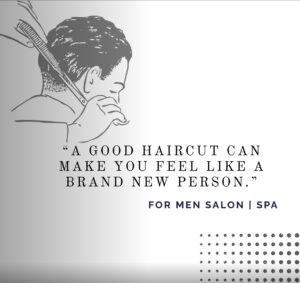
Want help figuring out a cut that suits your current hair? Talk to your men’s hairstylist at FOR MEN Salon | Spa and be open to change. Your hair is changing, and embracing it might be a less frustrating option. You never know, you may like that new hairstyle and find your hair is easier to manage.
A Men’s Salon Is Better to Help When Men’s Hair Changes
When it comes to adapting to the changes that come with aging hair, a men’s salon offers specialized advantages over traditional barbershops or quick-cut chains. A more personalized, professional approach to haircutting becomes essential as hair evolves. Not just to preserve an appearance, but to ensure the hair stays manageable.
Here’s why a men’s salon is uniquely positioned to help:
1. Expertise in Aging Hair:
Stylists at professional men’s salons are trained to recognize the subtle signs of hair loss, shifting growth patterns, and changes in texture. They can tailor haircuts to flatter a man’s current hair density and structure, rather than simply repeating a past look that no longer suits him.
2. Custom Consultations:
Men’s salons often offer more in-depth consultations. Taking time to understand the client’s hair history, lifestyle, and preferences. This holistic approach results in more informed decisions about a haircut, style, and maintenance routine.
3. Advanced Tools & Techniques:
Men’s salons offer a broader range of haircutting tools and styling methods. From texturizing shears to precision motorized tools, these allow for nuanced shaping that can compensate for thinning areas or unruly cowlicks in ways standard clippers can’t.
4. Access to Specialized Products:
Haircare for aging hair often requires specific products, such as volumizers, moisture-rich conditioners, and gentle cleansers. A men’s salon typically stocks professional-grade products formulated for different hair types, textures, and concerns. Men’s hairstylists can guide clients in choosing what is right for their needs.
5. Ongoing Hair Health Advice:
Beyond haircutting and styling, many men’s salons offer scalp treatments and hair health assessments. They can even refer clients to dermatologists or trichologists for more advanced concerns. This long-term perspective supports both the aesthetic and functional aspects of hair as it changes.
Men’s Hair Changes with Age and Where To Go Should Too
Hair will inevitably change as men age. There is no stopping it. But how men respond to those changes makes all the difference. Holding onto an old haircut out of habit might be comforting, but it can also be counterproductive when the hair no longer grows or behaves the same way.
A professional men’s salon doesn’t just give haircuts. It provides clients with a plan. With the right expertise, tools, and care, a men’s hairstylist can help men embrace those changes, adapt a hairstyle, and keep men looking sharp at any stage of life.
So, the next time you are tempted to ask for “the usual,” consider asking for a fresh perspective instead. Your hair has changed—your approach should, too.
Best Men’s Haircuts for Age-Related Hair Changes
Understanding why hair changes is one thing—choosing a haircut that works with those changes is another. The good news? With the right style and barber, men can not only adapt but actually enhance their appearance as they age. The key is selecting haircuts that complement the hair’s evolving texture, density, and growth patterns, rather than fighting against them.
Here are some of the best haircut options for men who are navigating the natural changes of aging hair:
1. The Textured Crop
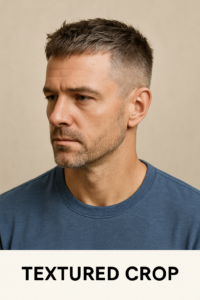
The Textured Crop is a modern, stylish haircut featuring short to medium-length hair on top, layered, and point-cut hair to create a choppy, textured appearance. The sides and back are usually tapered or faded shorter, providing contrast and highlighting the messy, volume-rich top. A textured crop is an excellent option for men experiencing thinning or shifting hair patterns. By adding intentional texture through cutting techniques, this style creates the illusion of volume and density, making hair appear fuller and more dynamic.
Why it works:
The textured layers add movement and fullness, making hair appear thicker and healthier, a major advantage for men experiencing thinning or fine hair. Textured crops embrace natural hair growth patterns, making them ideal for hair that has become less predictable with age. Plus, they require minimal styling to look intentional and effortless. Textured crops embrace changes in hair thickness and growth direction. They work particularly well with fine or thinning hair because the layers and choppy ends add movement and body without needing heavy styling.
Best for:
Men with thinning crowns, receding hairlines, or fine hair that needs a lift.
2. The Classic Short Back and Sides

The Classic Short Back and Sides is a timeless haircut where the back and sides are clipped short, while the top is left longer to allow for a range of styling options. It can be combined with a taper or fade to create a seamless, clean finish. The short back and sides haircut is a timeless choice. This option keeps hair neat and sharp, whether with a low fade, taper, or clipper cut. The contrast between shorter sides and slightly longer top draws attention upward, away from thinning areas.
Why it works:
This cut creates structure and sharpness without relying on thick hair. Keeping the sides and back tight draws the eye upward, enhancing the appearance of volume on top. It’s also versatile — you can slick the top back, part it to the side, or leave it casually tousled depending on your hair’s current texture and density. Also, keeping the sides tighter reduces the appearance of sparse patches while allowing more freedom to style the top. It creates a clean, youthful look without requiring a thick, full head of hair.
Best for:
Men beginning to notice thinning at the temples or crown, but who still have decent coverage on top.
3. The Crew Cut
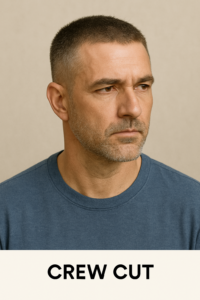
The Crew Cut is a short, tapered haircut where the top is kept slightly longer than the sides and back, offering a clean and athletic look. This timeless style strikes the perfect balance between practicality and subtle style, making it a go-to option for men at any age. The crew cut is a low-maintenance, no-fuss option that looks intentional and stylish at any age. It works particularly well for men whose hair is thinning evenly across the scalp, rather than in isolated patches.
Why it works:
The crew cut’s minimal length helps to conceal thinning hair by reducing the contrast between areas of different densities. Its simple structure also allows for easy maintenance and styling, ensuring a polished appearance with minimal effort. Short hair draws less attention to thinning areas and gives the appearance of thicker hair overall. Plus, the evenness of a crew cut minimizes contrast between areas of different density.
Best for:
Men with diffuse thinning or early-stage balding.
4. The Ivy League
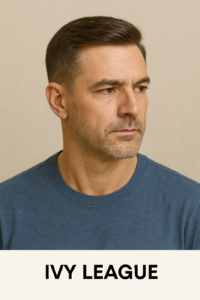
The Ivy League cut is a slightly longer variation of the crew cut that allows the hair on top to be styled into a side part or neatly combed back. This classic, refined style combines the shortness of a traditional crew cut with just enough length to add versatility. A longer, more sophisticated version of the crew cut, the Ivy League leaves enough length on top to part or style back, giving more versatility. This classic style is sharp enough for professional settings and flexible enough to adapt to changing hair textures.
Why it works:
The added length on top allows for the creation of volume, helping to mask thinning spots, especially near the crown or hairline. It’s an excellent choice for professional environments and social settings alike. It allows for the use of lightweight, volumizing products, giving thinning hair lift and dimension without requiring a lot of hair.
Best for:
Men who still want a polished, professional look with a bit more length to play with.
5. The Buzz Cut
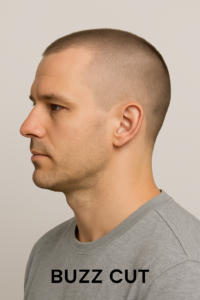
For many men, embracing simplicity with a buzz cut is the ultimate move when hair becomes noticeably thin or uneven. A buzz cut brings uniformity to the appearance of the scalp and hair, often making thinning areas look less pronounced. The Buzz Cut is a timeless, minimalist hairstyle characterized by its uniform length across the entire scalp. Achieved using electric clippers, this style offers a clean, low-maintenance look that accentuates facial features and is particularly flattering for men experiencing hair thinning or receding hairlines.
Why it works:
The buzz cut’s uniform short length minimizes the contrast between areas of varying hair density, making thinning less noticeable. Its simplicity reduces daily grooming time and provides a sharp, masculine appearance that suits various face shapes and hair types. By cutting the hair very short all over, the eye is no longer drawn to specific areas of loss. This style is easy to maintain and works with any hair growth pattern or scalp condition.
Best for:
Men with advanced thinning, noticeable bald spots, or significant texture changes.
6. The Modern Caesar Cut

The Modern Caesar Cut updates the traditional style with cleaner, sharper lines and often incorporates a fade or taper on the sides. The defining feature remains the short, horizontally cut fringe across the forehead. Characterized by short, horizontally cut bangs and a slightly longer top, the modern Caesar cut is designed to help mask receding hairlines while creating a structured look.
Why it works:
The fringe helps to disguise receding hairlines or thinning at the temples. By keeping the top relatively short but styled forward, it draws attention away from thinning areas while offering a strong, structured appearance. The fringe can cover part of the forehead and hairline, disguising recession, while the even layering creates a fuller, more solid look.
Best for:
Men with a receding hairline or thinning hair around the temples.
Pro Tip: Customize the Cut to Your Hair’s Needs
Men’s hair changes with age and no two heads of aging hair happen the same way. This is where working with a trained professional at a men’s salon becomes essential. A skilled stylist can customize the haircut to your unique hair growth patterns, texture, and density, ensuring the final look is flattering and functional.
They may also suggest subtle adjustments over time, such as:
- Tweaking the length to better balance thinner areas
- Introducing layering to add natural-looking volume
- Modifying the styling technique to work with changed texture or cowlicks
- Recommending lightweight products that don’t weigh down fine or thinning hair
Embrace Men’s Hair Changes with Age | Look Your Best
Aging is inevitable, but looking great through every decade is a choice. By understanding how hair changes and choosing the right haircut to match, men can stay confident, stylish, and authentic to themselves.
Remember: your hair isn’t what it used to be, and that’s okay. With the right haircut, style, and hair care routine, it can still look its absolute best.
Ready to Find the Right Cut for Your Changing Hair?
At FOR MEN Salon | Spa, we specialize in men’s hair at every stage of life. Whether you are noticing subtle changes or major shifts, our expert stylists are here to guide you with personalized advice, tailored haircuts, and premium care explicitly designed for aging hair. Men’s hair changes with age, but that does not need to stop you from having great hair.
Schedule your consultation today and discover a style that grows with you—not against you.
👉 Book Your Appointment Now or Text Us for a Consultation